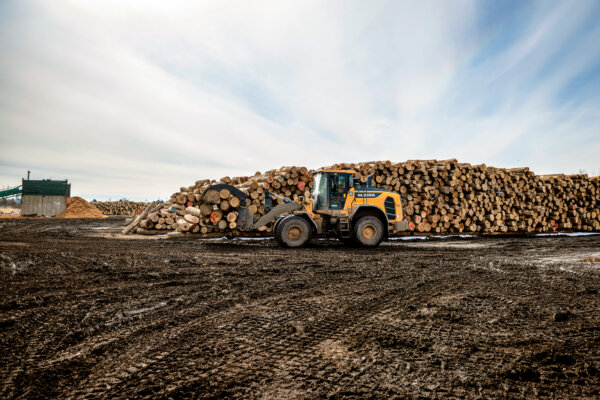![]() As the Trump administration looks to reset the global trade system, one of the longest-running international trade disputes in North America is returning to the forefront.
As the Trump administration looks to reset the global trade system, one of the longest-running international trade disputes in North America is returning to the forefront.
The root of the dispute can be traced in part to how land and the forests are owned. Canada’s vast forests are 90 percent publicly owned. Canada’s provincial governments, rather than the private market, decide which logging companies can access the resource and the price they pay for the privilege of felling trees.
In the United States, timberland is 90 percent privately owned. Landowners decide when to harvest and set their own fees.
The U.S. lumber industry is governed by the demand for, and the price of, the product, while Canadian timber companies can harvest as much as they want, whenever they want.
Canadian producers then dump this cheap product, the U.S. lumber industry contends, in a way that undercuts the American industry.
Since his inauguration in January, President Donald Trump has kept public pressure on the country regarding trade.
He has complained about Canada’s protectionist economic policies, has imposed new tariffs on imports of certain Canadian goods, and threatened to add more.
As a United States-Mexico-Canada Agreement-compliant product, Canadian lumber has been, and will continue to be, exempted from those tariffs, according to Zoltan van Heyningen, executive director of the U.S. Lumber Coalition.

That rate is currently set by the Department of Commerce at 14.4 percent. That duty is expected to more than double, to 34.45 percent after an administrative review of the current duty rate concludes later in 2025, van Heyningen told The Epoch Times.
These fees, he said, are designed to offset what the department has determined to be the artificially low cost of production enjoyed by Canadian lumber exporters.
The coalition describes itself as an alliance of softwood lumber producers and woodland owners “working to address Canada’s unfair lumber trade practices.”
The two countries have periodically jousted over the issue in the following years, with disputes frequently being adjudicated in the World Trade Organization, as well as the arbitration bodies of NAFTA.
The United States and Canada have drafted four different versions of what are known as softwood lumber agreements in an attempt to settle the issue.
The American lumber industry is currently working through a fifth round of trade cases filed with the Department of Commerce and the United States International Trade Commission, calling for an investigation into what it says are unfair Canadian business practices.

Nandalall said that Canada’s forestry industry is “woefully over-exposed to the U.S. market.” Almost 70 percent of its forestry exports go to the United States.
That executive order directed Secretary of Commerce Howard Lutnick to initiate an investigation and report his findings by the end of 2025.
Representatives of the Department of Commerce, the United States International Trade Commission, and the Embassy of Canada to the United States did not immediately respond to a request for comment from The Epoch Times.

Profitability Versus Affordability
Along with international issues, the long-running lumber dispute also pits American industries against each other.
On one side, the lumber producers—generally represented by the U.S. Lumber Coalition—are in favor of measures to limit what they see as product dumping by Canada, which artificially lowers the price American lumber can fetch and hurts demand for domestic products.
On the other side are American lumber buyers, who are looking to pay the lowest price possible for the product.
The National Association of Home Builders, representing companies that use lumber to frame single-family and multifamily homes in the United States, has been a vocal opponent of measures it sees as responsible for driving up the price of housing.
National Association of Homebuilders chairman Buddy Hughes said his organization fights against tariffs because of “their detrimental effect on housing affordability.”
“The tariffs act as a tax on American builders, home buyers, and consumers,“ Hughes said in a statement provided to The Epoch Times. ”The on-again, off-again nature of the tariffs and threats of higher levies has already had a negative effect on housing affordability by creating business uncertainty and disrupting building material supply chains.”
Hughes added that the United States is dependent on lumber imports and, even if it wanted to, cannot currently produce enough lumber domestically to meet U.S. demand. He said it would “take many years to build the necessary infrastructure to turn that timber into lumber.”

U.S. Lumber disagrees with that argument. Van Heyningen said the cost of lumber accounts for less than 2 percent of the overall cost of a home.
Additionally, the cost of lumber has dropped by at least 67 percent since reaching a high in May 2021. During that same period, the cost of a new home rose by 21 percent.
The import duties, van Heyningen said, are not paid by the customer, but rather by the Canadian lumber companies. He said importers of record in the United States—which are owned by the major Canadian lumber companies such as West Fraser Timber and Canfor—have paid at least $7 billion in fees since 2016.
“Lumber just doesn’t affect housing affordability,” van Heyningen said.
As for capacity, van Heyningen said U.S. policy is effectively slowing down the flow of Canadian softwood lumber into the United States. Canada’s current market share is down to its lowest level since the 1970s, in part due to a tougher enforcement stance adopted by the Trump administration.
Less Canadian lumber flowing into the United States, van Heyningen said, is allowing domestic producers to drive up their output. Since 2016, United States lumber milling has risen, while Canadian milling has fallen.
For example, since 2016, according to data provided to The Epoch Times by Forest Economic Advisors, American sawmills’ output capacity grew by about 9 million board feet. Canadian sawmill capacity dropped by about 3 million board feet.

The addition of this new capacity, van Heyningen said, is proof that the United States is capable of growing and milling enough timber to supply its own needs, when it is not being undercut by Canadian competitors.
He believes the United States can become self-sufficient if given a fairer relationship between the United States and Canada.














